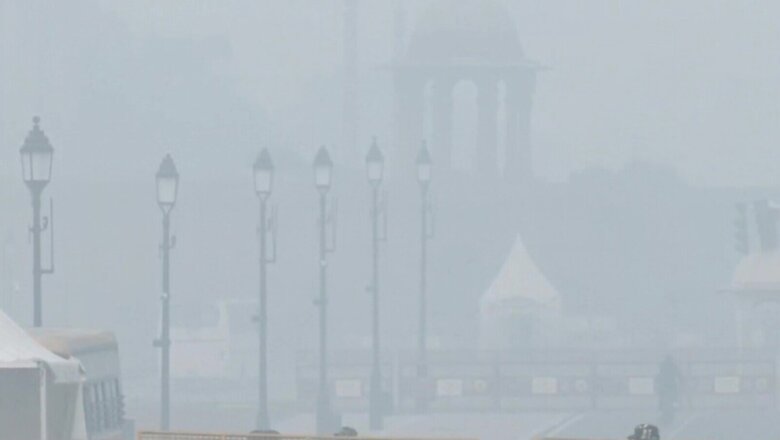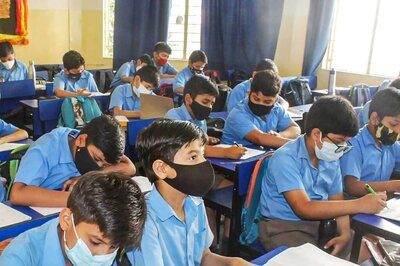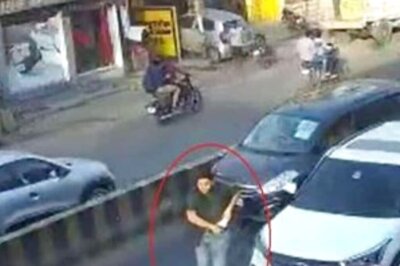
views
A layer of thick smog continues to shadow the national capital as its 24 hour average Air Quality Index (AQI) stood at 424 at 4 Pm on Tuesday, the worst this year.
On Wednesday at 6 AM, this trend continued with several areas in Delhi recording an AQI of above 400, which falls in the “severe” category.
This comes as NASA’s satellite images showed a dense cluster of red dots, which means farm fires in Punjab and parts of Haryana. A layer of smoke was also seen over huge parts of the Indo-Gangetic plains, according to PTI.
This is the second time that Delhi’s AQI has slipped into the severe category. Earlier this year, it recorded 402 on January 2nd.
According to the date released by the Central Pollution Control Board (CPCB), Delhi’s air pollution rose to the upper end of the “severe” category at Burari Crossing with AQI of 477, Bawana at 465, Wazirpur at 467, Narela at 465, Vivek Vihar (457), Rohini (462), Jahangirpuri (475), Sonia Vihar (469) and Ashok Vihar (465).
On Tuesday morning, the AQI in Noida stood at 444, in Dhirpur the air quality went to 594, and in Gurugram it stood at 391, which falls in the “very poor” category.
How does poor AQI impact people?
Polluted air kills seven million people every year. According to the World Health Organisation, one-third of deaths worldwide from stroke, lung cancer and heart disease are due to air pollution.
If the AQI falls in the “severe” category it can have negative ramifications on healthy people along with seriously impacting those with existing illness.
A report by the Energy Policy Institute at the University of Chicago (EPIC)’s Air Quality Life Index (AQLI) released in June said that the residents of Delhi are expected to lose 10 years of life expectancy due to the poor quality of air.
The PM 2.5, the particles in the air that increase with pollution are lung-damaging. On Tuesday in Delhi, the PM.25 was above 450 micrograms per cubic meter, which is around 8 times above what is considered to be the safe limit.
PM2.5 can penetrate the lung barrier and enter the blood system. They can increase the risk of heart and respiratory diseases, as well as lung cancer.
Air pollution has a disastrous effect on children. Worldwide, up to 14% of children aged 5 – 18 years have asthma relating to factors including air pollution. Polluted air is also linked to childhood cancers.
Pregnant women are exposed to air pollution, it can affect fetal brain growth. Air pollution is also linked to cognitive impairment in both children and adults.
When does Delhi experience its worst air quality?
Delhi records its worst AQI from November 1 to November 15. During this period, its average concentration of PM2.5 is 285 micrograms per cubic meter.
This is also a time where temperatures start to go down and low wind speed along with decreasing temperatures allow for the accumulation of pollutants, Mahesh Palawat, vice president (meteorology and climate change), Skymet Weather told PTI.
What factors contribute to this?
The share of farm fires in Delhi’s PM2.5 pollution stood at 14 per cent on Tuesday, according to SAFAR, a forecasting agency under the Union Ministry of Earth Sciences. It was 22 per cent on Monday, 26 per cent on Sunday, the highest this year so far, and 21 per cent on Saturday.
In what is the highest so far this season, Punjab reported 2,131 farm fires. On Tuesday, 1,842 farm fires were there.
The Commission for Air Quality Management (CAQM) called the increased incidents of farm fires as a “matter of serious concern” for Delhi pollution.
A CAQM official said the sharp increase in the air quality index over the last five days has “more to do with meteorological and external factors”.
“It is more about meteorology — stagnant winds and relatively low night temperatures in October this year. The wind direction is changing continuously, so the net result (dispersion) is zero. This is evident from satellite images too,” he added.
Government actions
The Commission for Air Quality Management had on Tuesday directed the Delhi government to intensify preventive measures and consider deploying water sprinklers and anti-smog guns round-the-clock amid rising pollution in Delhi.
At a review meeting, the commission suggested to intensify measures to control the dust pollution and increase the frequency of water sprinklers and anti-smog guns.
“Since construction is banned for now, the city government can utilise the anti-smog guns and sprinklers available with these agencies,” a CAQM official said.
Apart from this, Centre’s air quality panel had on Saturday directed authorities to impose a ban on construction and demolition activities in Delhi-NCR, except in essential projects, and other curbs under stage three of the Graded Response Action plan (GRAP).
GRAP, which was first implemented in 2017, is set of anti-air pollution measures followed in the capital and its vicinity according to the severity of the situation.
This year, curbs on polluting activities are being imposed up to three days in advance based on forecasts.
If the AQI reaches a “Severe Plus” category, then there would be implementation of steps like a ban on entry of trucks into Delhi, allowing 50 per cent of staff to work from home in public, municipal and private offices, closure of educational institutions and the plying of vehicles on an odd-even basis, etc.
With agency inputs
Read all the Latest India News here


















Comments
0 comment